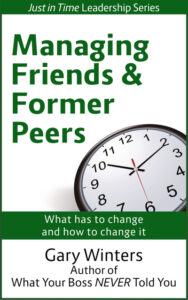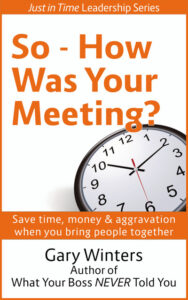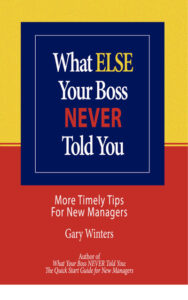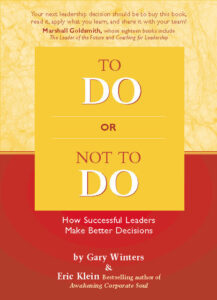Check out the "Just-in-Time" Leadership Series
Just-In-Time Leadership books are an ever-expanding catalogue of specific, bite-sized nuggets you can read in less than an hour, for about the cost of a cup of coffee. All my books are available as paperbacks and ebooks. Click on any title below for more information about the book.
Classic Best Sellers
These are full-size books – but don’t let that scare you. They’re written in a casual, conversational style, each with dozens of stories and anecdotes to illustrate effective management techniques.
What readers are saying on Amazon:
Most of us are not blessed with a manager’s quick start manual as we transition to a leadership role. Gary Winters, in What Your Boss Never Told You, bridges this gap with poignant anecdotes, razor sharp insights and actionable ways to jump start your career. It includes everything you wanted to know but didn’t know how to ask about getting started in management and includes timeless gems for the seasoned manager as well.

Something comes over people when they realize they're going to retire in a few short years.
Sooners, as Gary Winters calls these people in Managing the Soon to Retire Employee can pose real challenges for their managers. They've got one eye on the job, and one eye on the future, and several years to go before moving on.
They might be burned out, bored, or anxious about the future. They may feel isolated from colleagues. They may be tired of adapting to continual changes in the organization.
If you've got a Sooner who might be overwhelmed by the upcoming retirement, or who is having trouble staying focused and productive on the job, Managing the Soon to Retire Employee is a must read.
Whitey
"What Your Boss Never Told You" is an excellent book. I've read numerous management and supervision books over the years. This is one of the very best I've come across, and here's why. Gary Winters has a wonderful knack for getting right to the point, concisely and clearly. Also, Winters has made these management stories and lessons REAL. There is virtually nothing intellectual or scholastic about this book - and I seriously mean this as a high complement. Winters takes us for a walk through real workplaces, with real stories and real people trying to figure out how to become better managers. This book is chock full of practical tangible, useful wisdom.
Caseman
Where were Gary Winters and "What Your Boss Never Told You" when I really needed it? I am at the end of my career and I finally read a management book that encapsulates 40 years of learning the hard way. It is not so much a "how to" book as a "heads-up things to think about" book. The author doesn't provide pat solutions to every management situation, but makes the reader aware of what to look for to avoid managerial pitfalls. I couldn't find a single chapter where I didn't have an anecdote that supported author's assertions.
Lab Manager
Gary Winters does an amazing job of covering what front-line managers need to know and especially what they are not usually told. ALL aspiring managers, current supervisors, general managers, CEOs, and anyone interested in business will find the information useful.
Daryl Ligon
Easy to read with great advice and components you can put into place immediately. I've read many books and this one, by far, has the most practical advice.
Nara
"What Your Boss Never Told You" is exactly what every new supervisor/manager needs to help navigate the first 6 months in the new role! The issues that Winters has illustrated generally don't come up in management training, but they are vital to understand. This book isn't about "skill building," it's about the unexpected isses that pop up and require some thinking. Having this book is like having a mentor who knows just what you are dealing with and provides great advice!
Susan Gerke
"What Your Boss NEVER Told You" is a great book with very useful information.
Jaclyn Nicole
I have been a fan of Gary's many books on the topics of leadership, decision making, and management, as they are full of wisdom, wit, and they make you think about how to move forward. I was fortunate enough to be a beta reader for Gary on this book and once again, he has "hit it out of the park". Too many people become supervisors because they are good workers with no training or thought about what it means to be a supervisor. "Help! They Want to Make ME a Supervisor" discusses the topics that should be considered by anyone before the move up to being a supervisor.
Craig B
"Help! They're Making ME a Supervisor" is a very easy read that gives one many things to go over to help make the right decision. I definitely say if you have to decide on moving up to supervision, read Gary’s books. You won’t be sorry.
Cindy
Previous
Next
My sincere thanks to all my readers!














